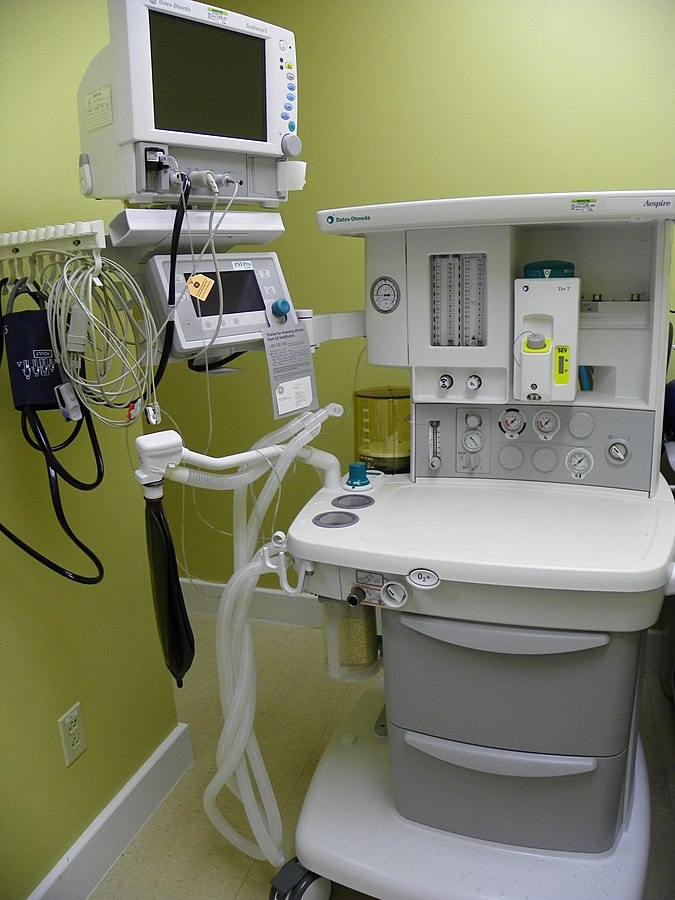Playlist
Show Playlist
Hide Playlist
Anesthetic Vapours – Gases and Induction Drugs
-
04 - Gases and Induction Drugs.pdf
-
Download Lecture Overview
00:01 More commonly we use vapours, and vapours are drugs that are liquid at room temperature but which is partially diffused into the atmosphere, exactly the same principles that are associated with water vapour which is all around us all the time. 00:17 Anesthetic vapours are calibrated to be released in a known concentration to the end of the patient’s circuit. 00:25 The first widely used vapour was ether, and ether was very safe. 00:31 It was very soluble in fat and it lasted a very long time. 00:35 The only anesthetic that I've ever had was an ether anesthetic when I was about 5 years old and I had my tonsils out as everybody did in that era, and they had two big men in the room that were there just to hold the patient’s down while they were breathing ether. 00:51 I was 5 years old, I didn’t think I had a lot of mass to hold down but they still needed to have these men in the room to do it. 00:59 Very slow onset, very slow recovery, often severe nausea and vomiting, no anesthetic properties at all -- excuse me - no analgesic properties at all, no pain killing property whatsoever but despite that it was quite safe and it’s still used in some developing countries. 01:18 Modern vapours are designed to have much higher fat solubility and have much more rapid onset of action than ether and also a much more rapid recovery and less hangover effect than ether used to cause. 01:33 The most modern drugs, desflurane and sevoflurane are the best in this respect. 01:41 Those drugs that came after ether such as halothane, methoxyflurane, enflurane, and isoflurane have largely disappeared from practice although isoflurane is still occasionally used. 01:53 With methoxyflurane, it was possible to measure methoxyflurane and fat stores up to a year after an anesthetic had been given. 02:01 With desflurane and sevoflurane, measuring for those drugs and fat stores they're absent within 24 hours. 02:09 So sevoflurane is a commonly used modern vapour anesthetic. 02:14 It has a sweet smell which is well tolerated by patients so it can be used instead of intravenous induction drugs in patients with needle phobias or with very poor venous access. 02:27 It’s also very popular in pediatric anesthesia because children are not as terrified by a mask as they are by a needle. 02:36 Even when used by inhalation it has a rapid onset and recovery is also quite quick but not as fast as you'll see with desflurane. 02:46 It has no analgesic properties whatsoever, and it can like all vapours cause nausea and vomiting. 02:54 Desflurane has a very rapid onset, recovery and little hangover but unfortunately it’s unsuitable formulation induction because it has a very pungent smell and people who breathe it tend to gag and are very uncomfortable so we don’t use it that way. 03:12 It’s very fat insoluble in fact it basically is as fat insoluble as nitrous oxide it’s the closest thing to nitrous oxide in terms of its fat solubility of any of the vapours. 03:26 Patients usually wakeup clear headed but it can still cause nausea and vomiting and again, it has no analgesic properties. 03:34 So modern vapours such as sevoflurane and desflurane have rapid onset and rapid recovery and less hangover than older vapours, but they do produce profound amnesia even in very low doses. 03:49 And amnesia is critical to anesthesia, to general anesthesia. 03:53 They do have respiratory and cardiovascular effects that we've already mentioned and these must be monitored. 03:59 They can produce nausea and vomiting and they can trigger malignant hyperthermia which we will talk about in another slide. 04:07 They have little or no analgesic effects so all of these drugs require augmentation by analgesics.
About the Lecture
The lecture Anesthetic Vapours – Gases and Induction Drugs by Brian Warriner, MD, FRCPC is from the course Anesthesiology: Introduction.
Included Quiz Questions
Which of the following statements about anesthetic vapors is TRUE?
- They all produce profound amnesia.
- They are all useful for inhalational induction of anesthesia.
- They are all extremely fat-soluble, so they last for only a short time.
- They have excellent analgesic properties.
- They all have a pleasant smell
Which of the following is a common feature between all old and new vapors?
- Absence of analgesic properties
- Low safety level
- Rapid onset and offset of action
- High fat solubility
- In the gas state at room temperature
In what way does sevoflurane differ from desflurane?
- Suitability for inhalation induction
- Malignant hyperthermia risk
- Nausea and vomiting risk
- Presence of analgesic properties
- Drug-induced amnesia properties
Customer reviews
5,0 of 5 stars
| 5 Stars |
|
5 |
| 4 Stars |
|
0 |
| 3 Stars |
|
0 |
| 2 Stars |
|
0 |
| 1 Star |
|
0 |




